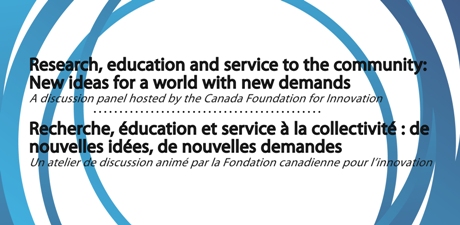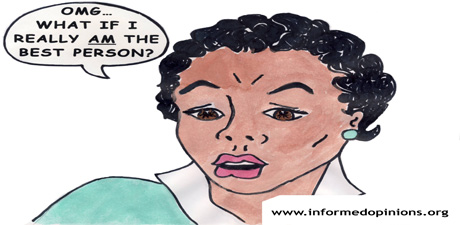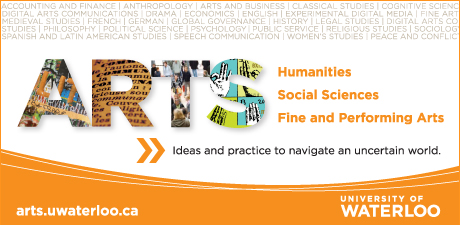Social innovation through collaboration
Mélanie Béchard
Canadian Federation for the Humanities and Social Sciences
There is an interesting theme woven throughout a number of sessions at Congress 2012. It began with the opening Big Thinking lecture from the Governor General when he said, “We must be as good in social innovation as we are in technological innovation.†It continued with the Canada Foundation for Innovation panel entitled “Research, education and service to the community,†where Reeta Tremblay of the University of Victoria noted, “What we’re seeing now is the co-creation of knowledge – a new architecture of knowledge creation.â€
That theme was picked up again yesterday morning during a panel organized by the Social Sciences and Humanities Research Council entitled “Partnerships in the Digital Economy.†The session brought together an interesting mix of university administrators, academics and grad students, along with some of their private sector partners, for a discussion on how these university-industry linkages are formed, particularly in the context of humanities and social science research.
Wendy Cukier, Vice President Research and Innovation at Ryerson University, explained that “partnerships provide a wealth of opportunities, not just funding.†For academics, the value of community partnerships comes from access to expertise, to data, and to feedback on their work.
“Working with partners has created enormous opportunities for students, and opportunities around knowledge dissemination,†she added.  Dr. Cukier’s own research into spam email and why it works – including an examination of the role of fairy tales and myth in human behaviour – led to a partnership with the Royal Canadian Mounted Police. “Some people really believe a Nigerian prince has left them $2.5 million,†she said.
Neil Randall, professor of English and Director for the University of Waterloo’s Games Institute, spoke about the IMMERSe project, which seeks to discover why games work. Dr. Randall said the goal is to promote ongoing academic-industry research in a collaborative, inter-, multi-, and single-disciplinary environment.
Academic partners include Concordia, McMaster and Carleton universities, the University of Ontario Institute of Technology, the University of California – Davis, the University of Southern California, and the University of Waterloo. Industry partners include Electronic Arts, Microsoft Studios, Pine Lake Communications, Communitech, Digital Extremes and the Ant Firm.
The IMMERSe project will also provide excellent training opportunities for graduate students, and Dr. Randall noted they will seek to continue to grow the network to include more industry and government partners.
Incidentally, the IMMERSe project, which stands for Interactive & Multi-Modal Experience Research Syndicate, was recently awarded a $2.5 million SSHRC Partnership Grant. Gary Goodyear, the Minister of State for Science and Technology, had high praise for the humanities and social sciences during his remarks at the opening reception for Congress last Friday night, when he made the announcement.
Geoffrey Shea of OCAD University talked about his three-year partnership with the Holland Bloorview Kids Rehabilitation Hospital in Toronto. Dr. Shea explained this collaboration is not static. “The concepts and impetus evolve over time. […] It’s more like a marriage,†he noted.
Elaine Biddiss, a scientist with the hospital, explained the first collaboration with Dr. Shea and his students was for the development of an interactive display in the waiting area to entertain children while they wait for their medical appointments. Dr. Biddiss noted that children at the hospital often has limited mobility, and can suffer from stress and anxiety in waiting rooms.
Together, the teams at OCADU and Holland Bloorview designed an interactive display that is triggered by a pressure-sensitive floor. Spots on the floor correspond with various flowers and plants, so moving around the floor can create the image of a garden or forest on the wall. “The longer you stay in one spot, your projection gets larger,†Dr. Biddiss explained.
While the hospital had the know-how to build the tool themselves, “we needed a partner to enhance the interactive experience,†Dr. Biddiss said. In turn, the project was a constructive one for the OCADU students. “The design students had to learn about the needs of kids with autism, the need for calming influences in waiting rooms,†Dr. Shea said.
The collaboration resulted in “a beautiful end product enjoyed by kids and families,†Dr. Biddiss noted. The team has since received funding from the Canadian Institutes of Health Research to evaluate the effectiveness of the tool in relieving children’s anxiety in this type of environment.
Dr. Cukier reminded the audience that, while these partnerships are important to improving the lives of Canadians, that can’t happen unless the outputs of the research are publicly available. “Disseminating the results of your research in a way that is accessible to a variety of audiences helps encourage future partnerships,†she said.









